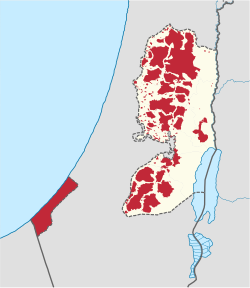Fatah government in Ramallah
|
Palestinian National Authority
السلطة الفلسطينية
as-Sulṭa al-Filasṭīnīya |
|
|---|---|

Map showing areas of Palestinian Authority control or
joint control (red) as of 2006. |
|
| Administrative center |
Ramallah 31°54′N 35°12′E / 31.900°N 35.200°E |
| Largest city |
Gaza 31°31′N 34°27′E / 31.517°N 34.450°E |
| Official languages | Arabic |
| Type | Provisional self-government body |
| Government | Semi‑presidential |
| Mahmoud Abbas | |
| Rami Hamdallah | |
| Legislature | Legislative Council |
| Autonomy from Israeli administration | |
| 13 September 1993 | |
| 1994 | |
| 1995 | |
| 2007 | |
| 29 November 2012 | |
| Currency |
|
| Time zone | EET (UTC+2) |
|
• Summer (DST)
|
EEST (UTC+3) |
| Date format | dd/mm/yyyy |
| Calling code | +970 |
| Internet TLD | .ps |
The Palestinian National Authority (PA or PNA; Arabic: السلطة الوطنية الفلسطينية as-Sulṭa al-Waṭanīya al-Filasṭīnīya) is the interim self-government body established in 1994 following the Gaza–Jericho Agreement to govern the Gaza Strip and Areas A and B of the West Bank, as a consequence of the 1993 Oslo Accords. Following elections in 2006 and the subsequent Gaza conflict between the Fatah and Hamas parties, its authority had extended only in areas A and B of the West Bank. Since January 2013, the Fatah-controlled Palestinian Authority uses the name "State of Palestine" on official documents.
The Palestinian Authority was formed in 1994, pursuant to the Oslo Accords between the Palestine Liberation Organization (PLO) and the government of Israel, as a five-year interim body. Further negotiations were then meant to take place between the two parties regarding its final status. According to the Oslo Accords, the Palestinian Authority was designated to have exclusive control over both security-related and civilian issues in Palestinian urban areas (referred to as "Area A") and only civilian control over Palestinian rural areas ("Area B"). The remainder of the territories, including Israeli settlements, the Jordan Valley region and bypass roads between Palestinian communities, were to remain under Israeli control ("Area C"). East Jerusalem was excluded from the Accords. Negotiations with several Israeli governments had resulted in the Authority gaining further control of some areas, but control was then lost in some areas when the Israel Defense Forces (IDF) retook several strategic positions during the Second ("Al-Aqsa") Intifada. In 2005, after the Second Intifada, Israel withdrew unilaterally from its settlements in the Gaza Strip, thereby expanding Palestinian Authority control to the entire strip while Israel retained to control the crossing points, airspace and the waters off its coast.
...
Wikipedia

